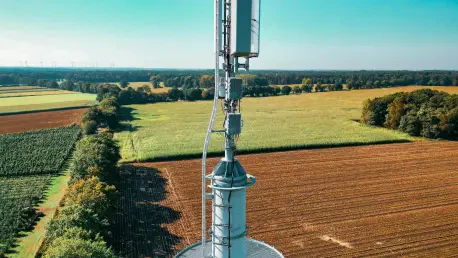In the evolving landscape of U.S. broadband services, Fixed Wireless Access (FWA) has emerged as a formidable contender against conventional cable and fiber-optic solutions. This technological evolution has been underscored by significant shifts in subscriber preferences. In a notable milestone, FWA operators T-Mobile, Verizon, and AT&T collectively added 703,000 net subscribers in the early months of the year. This growth contrasts sharply with the 652,000 new fiber subscribers, while cable providers saw a net loss of 323,000 customers. Such trends signal not only a change in consumer preference but also prompt an urgent discussion on the sustainability and future trajectory of FWA amidst its rising dominance.
FWA Growth and Emerging Dominance
Increasing Subscriber Base
The rapid adoption of FWA has surprised industry analysts who continue to observe its growing popularity across diverse geographic regions in the United States. The driving factors behind this trend are multifaceted. Consumers are increasingly attracted to the convenience and flexibility that FWA offers, as it typically involves lower costs and simpler installation processes compared to traditional fiber setups. The absence of the need for extensive physical infrastructure makes FWA particularly appealing in rural or underserved areas where laying fiber cables is often economically unfeasible.
Moreover, this subscriber growth is bolstered by improvements in service quality, largely attributed to advancements in 5G technology. The deployment of 5G has significantly enhanced the reliability and speed of FWA, making it a competitive alternative to fixed-line broadband services. As operators continue to expand their 5G networks, FWA is expected to become even more attractive to a broader range of consumers seeking high-speed Internet without the constraints of wired connections.
Advantages Over Traditional Broadband
FWA’s distinct advantages over cable and fiber have been pivotal in its recent ascendancy. These connections do not require extensive groundwork, which reduces installation time and costs, making it a viable option for both providers and consumers looking for rapid service deployment. This advantage is particularly evident in areas where fiber rollout is slow or delayed, offering inhabitants an immediate upgrade from older technologies.
Additionally, the scalability of FWA systems is another contributing factor to their popularity. As demand for higher internet speeds continues to grow, FWA can be expanded relatively quickly by upgrading base stations and leveraging additional spectrum. This ability to scale without significant infrastructure modification is vital in keeping pace with consumer expectations and technological advancements. FWA’s capability to address both individual and enterprise needs further distinguishes it as a flexible and future-proof choice in the broadband landscape.
Challenges Facing FWA Adoption
Network Capacity Constraints
While FWA continues to grow, there are underlying challenges, particularly pertaining to the limits of existing 5G networks. The burgeoning number of smartphone users, combined with other connected devices accessing these networks, is increasing the strain on available spectrum resources. The finite nature of the radio spectrum means that only so much data can be transmitted at any given time, imposing a ceiling on potential subscriber growth.
FWA’s sustainability is therefore tightly linked to the capacity of these 5G networks. As data consumption patterns evolve, with users streaming more high-definition content and engaging in data-intensive activities, the pressure on network capacity intensifies. Providers are actively seeking solutions to manage this demand, including technological innovations and strategic spectrum management. Without effective interventions, the burgeoning demand threatens to outstrip the current capacity, leading to potential service quality degradation.
Importance of Spectrum Management
The centrality of spectrum in sustaining FWA growth cannot be overstated. Operators like Verizon make strategic use of spectrum resources, while T-Mobile is rapidly closing the gap in utilization. In contrast, AT&T, with a more conservative FWA expansion strategy, finds itself with a healthier spectrum position that allows more room for future growth. However, as FWA continues to expand, overall spectrum availability becomes a critical issue for all players in the market.
The constraints of spectrum availability underscore the urgency for efficient spectrum management. To avert potential bottlenecks, providers must explore groundbreaking technologies that optimize spectrum usage, such as advanced beamforming and the adoption of AI-enhanced networks. These solutions offer hope in squeezing more efficiency out of the existing spectrum, providing a buffer that could delay the onset of capacity issues while the search for new spectrum allocations continues.
Advocacy and Industry Dynamics
Lobbying Efforts for More Spectrum
Amid rising concerns about spectrum scarcity, industry associations like CTIA have been vocal in their advocacy for the release of additional spectrum assets. They argue that without preemptive regulatory measures to free up more spectrum, the industry risks falling behind global competitors like China. CTIA’s lobbying underscores a broader industry consensus on the importance of spectrum for maintaining competitive market positions and stimulating further innovation.
The call for more spectrum is not without controversy. Within industry circles, some analysts argue that CTIA’s alarmist narrative may be somewhat exaggerated, aimed at galvanizing governmental action that aligns with long-term business interests. While the demand for additional spectrum is indisputable, the timelines for a critical shortfall remain debated. There are suggestions that with strategic planning and incremental innovations, the immediate impact of spectrum limitations might be mitigated.
Criticisms and Alternative Perspectives
Despite the push for additional spectrum, skeptics remain critical of the industry’s narrative. They suggest that the perceived urgency may serve to unduly pressure regulatory bodies into releasing valuable spectrum assets primarily benefiting major operators. Critics posit that advancements in technological solutions, such as densifying networks through the deployment of smaller cells or tapping into emerging technologies like AI for network optimization, may offer alternative routes to sustaining growth.
Further skepticism targets the pace of network densification, which has not met initial expectations. The slow rollout of enhanced infrastructure leaves networks vulnerable to future demand pressures. If innovations in technology and spectrum management do not arrive in time, networks may experience congestion sooner than anticipated. Analysts also highlight opportunities in sharing or reallocating existing spectrum among providers to optimize its use, pointing to efficiency as a necessary strategy moving forward.
Future Outlook and Strategic Considerations
Managing Expectations and Strategic Decisions
As the landscape of broadband continues to evolve, fixed wireless access stands at a crossroads. Its widespread adoption marks a significant shift in consumer preferences, yet its future hinges on resolving network capacity challenges. Effective management of spectrum resources and technological adoption will define the potential for sustained FWA expansion. Providers must balance rapid growth ambitions with strategic investments that enhance network robustness and scalability.
The competitive dynamics between cable, fiber, and FWA will likely intensify, prompting providers to sharpen their focus on delivering differentiated and value-laden services. As consumer practices adjust to the availability of new technologies, the ability of providers to meet these demands flexibly will determine market leadership. Long-term strategies will involve collaboration across the industry, including partnerships, joint ventures, or alliances, each playing a role in shaping the next phase of broadband evolution.
Exploring Technological Innovations
The exploration and implementation of cutting-edge technology will be pivotal in addressing FWA’s capacity limitations. Innovations such as massive MIMO (Multiple Input, Multiple Output), advanced carrier aggregation, and beamforming are essential in enhancing spectrum efficiency. These technologies have the potential to unlock new capacities within existing networks, offering relief from immediate congestion challenges while paving the way for further advancements.
Investments in AI-driven technologies could revolutionize network management by predicting usage patterns and dynamically allocating resources to optimize performance. Similarly, blockchain technology holds promise for more efficient spectrum allocation, minimizing human errors and regulatory bottlenecks. Ultimately, the convergence of these technological fronts with FWA infrastructure could herald a new era in broadband innovation, where seamless connectivity becomes the norm rather than the exception.
Navigating the Road Ahead
In the dynamic world of U.S. broadband services, Fixed Wireless Access (FWA) has emerged as a serious competitor to traditional cable and fiber-optic connections. This development highlights significant changes in subscriber preferences. Recently, FWA operators T-Mobile, Verizon, and AT&T collectively added a whopping 703,000 net subscribers early this year. In stark contrast, fiber services bolstered their numbers with 652,000 new subscribers, while cable providers experienced a setback, losing 323,000 customers. These statistics highlight an ongoing shift in consumer choices, indicating a growing interest in FWA over more established technologies. The surge in FWA adoption suggests that consumers are drawn to its potential benefits, which may include greater cost-effectiveness, flexibility in installation, and potentially wider accessibility in certain geographic areas compared to fiber. This trend prompts a critical discussion about the long-term sustainability and future direction of FWA as it continues to gain ground in the broadband market. As consumer preferences evolve, industry stakeholders must contemplate how FWA’s rise will impact traditional providers and its role in shaping the broadband landscape of the future.









